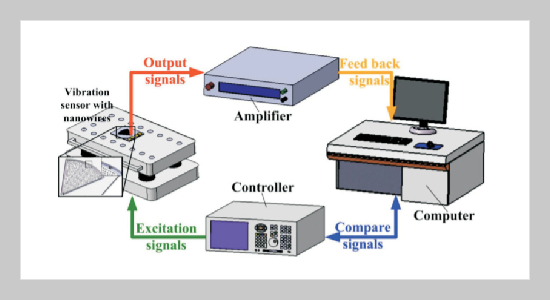REFERENCES
- [1] Samuel, B. A., Desai, A. V. and Haque, M. A., “Design and Modeling of a MEMS Pico-Newton Loading/ Sensing Device,” Sensors and Actuators A, Vol. 127, pp. 155�162 (2006). doi: 10.1016/j.sna.2005.11.018
- [2] Desai, A. V. and Haque, M. A., “Mechanical Properties of ZnO Nanowires,” Sensor and Actuators A, Vol. 134, pp. 169�176 (2007). doi: 10.1016/j.sna.2006.04. 046
- [3] Budrovic, Z., Swygenhoven, H. V., Derlet, P. M., Petegem, S. V. and Schmitt, B., “Plastic Deformation with Reversible Peak Broadening in Nanocrystalline Nickel,” Science, Vol. 304, pp. 273�276 (2004). doi: 10.1126/science.1095071
- [4] Lu, L., Shen,Y. F., Chen, X. H., Qian, L. H. and Lu, K., “Ultrahigh Strength and High Electrical Conductivity in Copper,” Science, Vol. 304, pp. 422�426 (2004). doi: 10.1126/science.1092905
- [5] Lee, S. K., Choi, H. J., Pauzauskie, P., Yang, P., Cho, N. K., Park, H. D., Suh, E. K., Lim, K. Y. and Lee, H. J., “Gallium Nitride Nanowires with a Metal Initiated Metal-Organic Chemical Vapor Deposition Approach,” Physics Status Solid C, Vol. 241, pp. 2775�2778 (2004). doi: 10.1002/pssb.200404989
- [6] Wang, Z. L., Poncharal, P. and de Heer, W. A., “Nanomeasurements of Individual Carbon Nanotubes by InSitu TEM,” Pure and Applied Chemistry, Vol. 72, pp. 209�219 (2000). doi: 10.1351/pac200072010209
- [7] Champion, Y., Langlois, C., Guérin-Mailly, S., Langlois, P., Bonnentien, J. L. and Hÿtch, M. J., “Near-Perfec Elastoplasticity in Pure Nanocrystalline Copper,” Science, Vol. 300, pp. 310�311 (2003). doi: 10.1126/ science.1081042
- [8] Wu, B., Heidelberg, A. and Boland, J. J., “Mechanical Properties of Ultrahigh-Strength Gold Nanowires,” Nature Material, Vol. 4, pp. 525�529 (2005). doi: 10.1038/nmat1403
- [9] Ju, Y., Amano, M. and Chen, M., “Mechanical and Electrical Cold Bonding Based on Metallic Nanowire Surface Fasteners,” Nanotechnology, Vol. 23, pp. 365202 (2012). doi: 10.1088/0957-4484/23/36/365202
- [10] Wang, P., Ju, Y., Hosoi, A. and Song, Y. H., “Room-Temperature Bonding Technique Based on Copper Nanowire Surface Fastener,” Applied Physics Express, Vol. 6, pp. 035001 (2013). doi: 10.7567/APEX.6.035001
- [11] Yue, Y., Chen, M., Ju, Y. and Zhang, L., “Stress-Induced Growth of Well-Aligned Cu2O Nanowire Arrays and Their Photovoltaic Effect,” Scripta Materialia, Vol. 66, pp. 81�84 (2012). doi: 10.1016/j. scriptamat.2011.09.041
- [12] Zhang, L., Lu, J., Takagi, H. and Maeda, R., “A Theoretical Study on Sensitivity of Planar Piezoresistive Vibration Sensor,” Japanese Journal of Applied Physics, Vol. 52, pp. 106502 (2013).
















